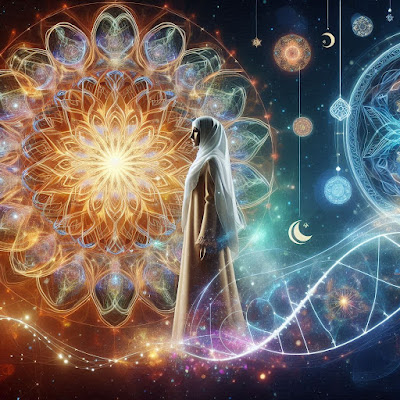Sacred Geometry and the Beauty of Divine Alignment: A Journey Back to Allah
How the Patterns of Creation, Time, and Worship Lead to Balance, Rhythm, and Inner Beauty
1. The Signature of Allah in Sacred Geometry
In the natural world, beauty is not accidental—it is purposeful and divine. Sacred geometry, evident in the spirals of galaxies, the arrangement of petals in flowers, and even the human body, is Allah’s signature woven into creation. These patterns embody balance and harmony, showing how the universe reflects a deeper order:
"He created everything and determined it in precise measure" (Qur’an 25:2).
Sacred geometry reveals Allah’s wisdom in creating a system where everything is interconnected. The Fibonacci sequence, the golden ratio, and fractals—patterns found in both the largest galaxies and the smallest cells—remind us that every element is part of a larger, divine rhythm.
In our bodies, this rhythm is encoded in DNA, whose spiral structure mirrors the sacred forms found in nature. The precise balance of hydrogen bonds and the elegant folding of proteins point to a Creator who harmonized every detail. When these structures are aligned—within the body and with the rhythms of time—they radiate beauty.
2. Time as a Reflection of Divine Rhythm
Time, much like sacred geometry, is not random but deeply structured. It is cyclical yet linear, with recurring rhythms guiding every aspect of creation:
- The 24-hour day is divided into light and darkness, aligning with our circadian rhythms.
- The moon phases regulate tides, and by extension, human biology and emotional states.
The Qur’an often swears by time, emphasizing its sacredness and urging us to reflect on its flow:
"By the morning brightness, and by the night when it covers with darkness..." (Qur’an 93:1-2).
When we align our lives with these rhythms, we tap into the sacred geometry of time. The Prophet Muhammad (PBUH) structured daily life around such rhythms: the five prayers (Salah) are a profound act of synchronizing with the Creator’s time. Each prayer connects us to a specific moment, creating an energetic recalibration akin to aligning with the magnetic fields of the earth.
3. Sacred Geometry in the Body: A Living Reflection
The human body is a masterpiece of divine proportion. From the symmetry of the face to the golden ratio seen in the proportions of limbs, the body echoes the harmony found in sacred geometry. This alignment is not just physical—it reflects the soul’s state:
"And We have certainly created man in the best of stature" (Qur’an 95:4).
When the body aligns with the rhythms of life, it functions as it was designed to:
- Teeth and Bones: The fractal geometry of bone structure enables strength and resilience. Misalignment here can reflect deeper disharmony.
- DNA’s Spiral: Beyond its beauty, DNA's rhythm influences cellular repair and growth, processes governed by circadian cycles.
The body’s design invites us to care for it as a sacred trust (Amanah). Aligning our physical form through acts of worship, such as bowing and prostrating in Salah, reinforces harmony with divine order.
4. Returning to Allah: The Ultimate Beauty of Alignment
Sacred geometry and time remind us that our beauty—physical, emotional, and spiritual—is a reflection of our alignment with Allah’s rhythms. To cultivate this alignment:
- Worship as Sacred Rhythm: Salah integrates movement, breath, and timing into a geometrical act of submission. Each posture mirrors humility and balance, synchronizing the body with divine energy.
- Fasting as Cellular Renewal: During Ramadan, fasting realigns the body with natural cycles. Research shows fasting activates autophagy, where the body cleanses itself—a physical reflection of spiritual purification.
- Reflection on Nature: Observing sacred patterns in the natural world fosters a sense of awe and gratitude, bringing the heart closer to Allah.
The Qur’an also invites us to look beyond the self and see the larger rhythm of creation:
"The sun and the moon move by precise calculation, and the stars and trees prostrate" (Qur’an 55:5-6).
Sacred geometry is not just an abstract concept; it offers us tools to return to Allah:
- Structure of the Prayer Mat: The geometry of the prayer mat subtly mirrors alignment. When standing in Salah, the lines guide the body, echoing a deep connection between the self and the Qiblah (direction of prayer).
- The Kaaba as Geometry: The Kaaba’s cubic form reflects balance and stability, central to sacred geometry. Tawaf (circumambulation) around it mirrors the orbits of celestial bodies, aligning the soul with universal rhythms.
By turning to Allah, we activate the sacred geometry within, creating beauty not just outwardly but in our character, thoughts, and actions.
6. Creating Beauty Through Alignment
When we realign our lives with Allah’s divine order, we begin to embody the very beauty He has designed us for. Sacred geometry, when practiced through worship and reflection, restores balance and rhythm:
- Inner Beauty: Gratitude, patience, and humility radiate outward, creating harmony with those around us.
- Outer Beauty: Aligning with divine rhythms supports physical health, glowing skin, and peaceful expressions—natural outcomes of balance.
Turning back to Allah is the ultimate act of alignment. By seeking Him, we tap into the sacred patterns that guide the universe, discovering that the greatest beauty is to be found in His remembrance:
"Indeed, in the remembrance of Allah do hearts find rest" (Qur’an 13:28).
Further Reading:
- Sacred Geometry: Unlocking the Rhythms of Creation
- Time and Structure: The Balance of Justice in Surah Ar-Rahman
- The Harmony of Body, Time, and Worship in Islam





Comments
Post a Comment